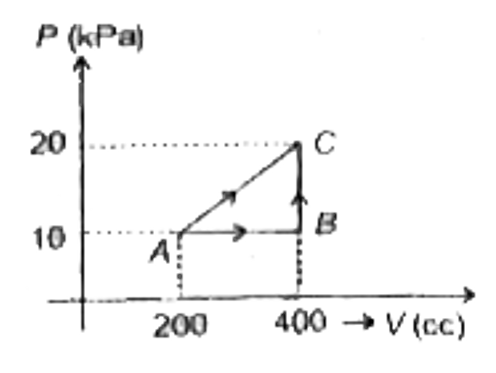A gas undergoes change from state A to state B. In this process, the heat absorbed and work done by the gas is 5 J and 8 J, respectively. Now gas is brought back to A by another process during which 3 J of heat is evolved. In this reverse process of B to A:
6 J of the work will be done by the gas
6 J of the work will be done by the surrounding on gas
10 J of the work will be done by the surrounding on gas
10 J of the work will be done by the gas
The correct Answer is:B
To solve the problem step by step, we will analyze the changes in the gas's state and apply the first law of thermodynamics.
Step 1: Understand the Process from A to B
- The gas absorbs heat (Q) and does work (W) during the transition from state A to state B.
- Given:
- Heat absorbed (Q) = +5 J (since heat is absorbed, it is positive)
- Work done by the gas (W) = -8 J (work done by the system is negative)
Step 2: Calculate the Change in Internal Energy (ΔU) from A to B
- According to the first law of thermodynamics:
ΔU=Q+W
- Substituting the values:
ΔU=5J+(−8J)=5J−8J=−3J
- Thus, the change in internal energy from A to B is ΔU = -3 J.
Step 3: Understand the Process from B to A
- The gas is brought back to state A from state B, during which heat is evolved.
- Given:
- Heat evolved (Q) = -3 J (since heat is released, it is negative)
Step 4: Calculate the Change in Internal Energy (ΔU) from B to A
- We know from the previous step that ΔU from A to B was -3 J. For the reverse process (B to A), the change in internal energy will be the same in magnitude but opposite in sign:
ΔU=+3J
Step 5: Apply the First Law of Thermodynamics for the Process from B to A
- Again, using the first law:
ΔU=Q+W
- Substituting the values:
3J=−3J+W
- Rearranging gives:
W=3J+3J=6J
- This means that 6 J of work is done on the gas by the surroundings.
Step 6: Interpret the Result
- Since the work done (W) is positive, it indicates that the work is done on the gas by the surroundings.
Conclusion
- The correct interpretation of the results is that 6 J of work is done on the gas by the surroundings.
- The gas absorbs heat (Q) and does work (W) during the transition from state A to state B.
- Given:
- Heat absorbed (Q) = +5 J (since heat is absorbed, it is positive)
- Work done by the gas (W) = -8 J (work done by the system is negative)
- According to the first law of thermodynamics:
ΔU=Q+W
- Substituting the values:
ΔU=5J+(−8J)=5J−8J=−3J
- Thus, the change in internal energy from A to B is ΔU = -3 J.
- The gas is brought back to state A from state B, during which heat is evolved.
- Given:
- Heat evolved (Q) = -3 J (since heat is released, it is negative)
- We know from the previous step that ΔU from A to B was -3 J. For the reverse process (B to A), the change in internal energy will be the same in magnitude but opposite in sign:
ΔU=+3J
- Again, using the first law:
ΔU=Q+W
- Substituting the values:
3J=−3J+W
- Rearranging gives:
W=3J+3J=6J
- This means that 6 J of work is done on the gas by the surroundings.
- Since the work done (W) is positive, it indicates that the work is done on the gas by the surroundings.
- The correct interpretation of the results is that 6 J of work is done on the gas by the surroundings.
Similar Questions
Knowledge Check
An ideal gas system undergoes an isothermal process, then the work done during the process is
AnRTln(V2V1)BnRTln(V1V2)C2nRTln(V2V1)D2nRTln(V1V2)
In isobaric process of ideal gas (f=5) work done by gas is equal of 10J. Then heat given to gas during process:
View SolutionA gas undergoes a change of state during which 100J of heat is supplied to it and it does 20J of work. The system is brough back to its original state through a process during which 20 J of heat is released by the gas. What is the work done by the gas in the second process?
View SolutionIn a process, 701 J of heat is absorbed by a system and 394 J of work is done by the system. What is the change in internal energy of the process?
View SolutionIn a isobaric process the work done by a di-atomic gas is 10 J , the heat given to the gas will be :
View SolutionIf a gas is taken from A to C through B then heat absorbed by the gas 8 J . Heat absorbed by the gas in taking it from A to C directly is

View SolutionA perfect gas goes from a state A to another state B by absorbing 8 × 105 J of heat and doing 6.5 × 105 J of external work. It is now transferred between the same two states in another process in which it absorbs 105 J of heat. In the second process work done by the gas is ?
View SolutionIn a process, 701J of heat is absorbed by a system and 394J of work is done by the system. What is the change in internal energy for the process?
View Solution

